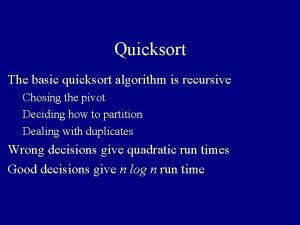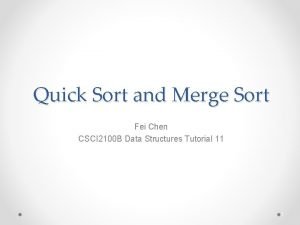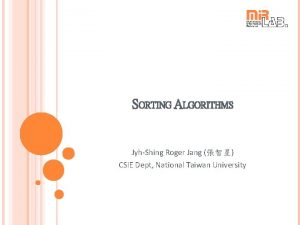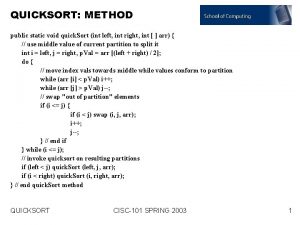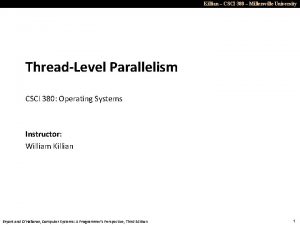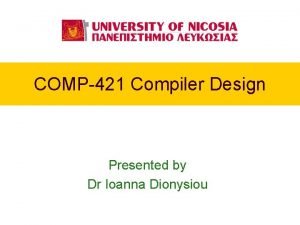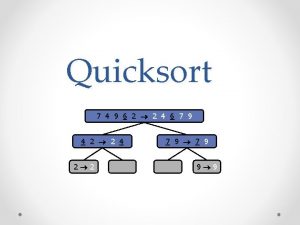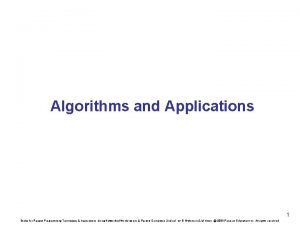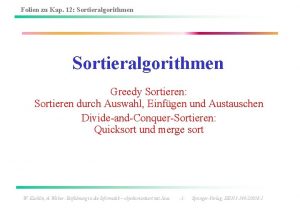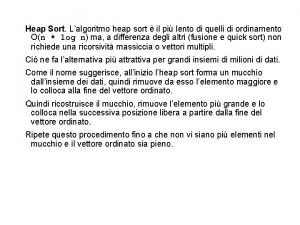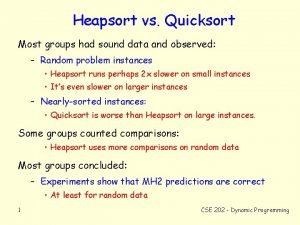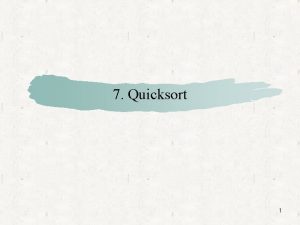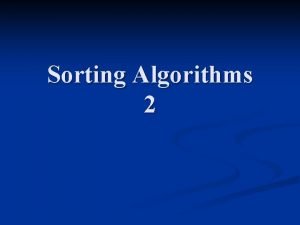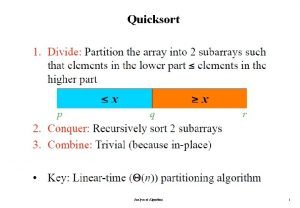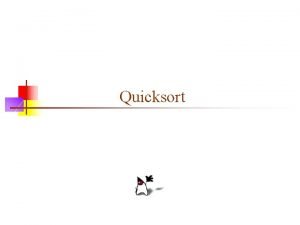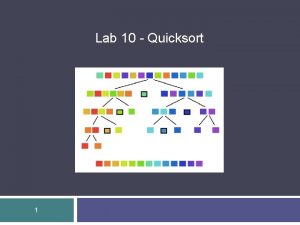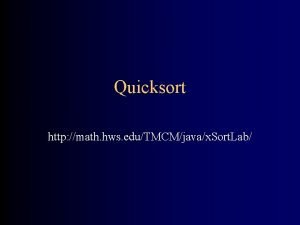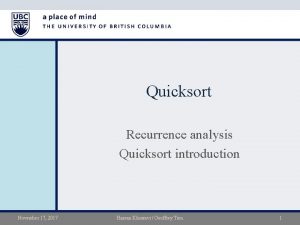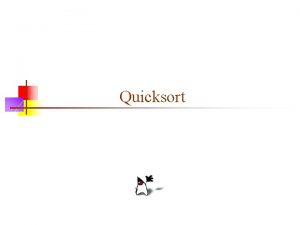Algorithms Lecture 26 Quicksort Quicksort Up to now



















- Slides: 19

Algorithms Lecture 26

Quicksort

Quicksort • Up to now, we were (mostly) looking at randomized algorithms that have some fixed running time, but fail with some probability – We were interested in the failure probability • Here we look at a randomized algorithm that always succeeds, but whose running time varies – We are interested in the expected running time

Quicksort • A quick, randomized sorting algorithm • The algorithm has a O(n 2) worst-case running time, but O(n log n) expected running time

Quicksort • Quicksort(A) If |A| < 4 then sort A directly Else Choose a uniform element a of A A 1 = elements of A smaller than a A 2 = elements of A larger than a A’ 1 = Quicksort(A 1), A’ 2 = Quicksort(A 2) output A’ 1, a, A’ 2

Analysis • Call a the pivot • In the worst case, a might always be the smallest element of A – Then T(n) = T(n-1) + O(n) = O(n 2) • However, this is extremely unlikely!

Analysis • Say a is good if the rank of a is in the 25 -75% range – In this case, quicksort partitions A into two subproblems of roughly equal size – In particular, if this happens every time then T(n) ≤ 2 T(3 n/4) + O(n) = O(n log n) • Note that a is good with probability ½

Analysis • Consider a modified version of quicksort that chooses another a if it is not good • The expected number of times a is chosen is 2 The expected work done (not including the recursive calls) on an array of length n is O(n)

Analysis • In this modified algorithm, the recursive calls form a (possibly incomplete) binary tree with at most O(log n) levels – The expected work done at each level is O(n) • By linearity of expectation, the expected work done overall is O(n log n)

Analysis • Alternate approach (more formal; applies to original algorithm) • Let a 1, …, an be the elements of A in sorted order • Let Xi, j = 1 iff ai and aj are compared • Work of quicksort = i<j Xi, j – So the expected work of quicksort is i<j Pr[Xi, j = 1]

Analysis • Note that ai, aj are compared only if the first pivot chosen in the range ai, …, aj is ai or aj • So Pr[Xi, j = 1] = 2/(j – i + 1) • i<j Pr[Xi, j = 1] = i j>i 2/(j – i + 1) < i k 2/k = i O(log n) = O(n log n)

Analysis • Besides analyzing the expected running time, it is also possible to show that quicksort has good running time with high probability

Hash tables/ load balancing

Hash tables • Want to maintain a set S = {x 1, …, xm} U of size m = |S| using space << |U| – Support the following operations: insert, lookup • Idea: use an array of n linked lists, where an item x S is stored at position H(x) for some hash function H – Insert/lookup involve computing H and traversing a linked list • Want to bound the maximum length of any list

Hash tables • We will model H as a truly random function – Note: this is not correct; it is just a (heuristic) approximation – Can analyze specific hash function families, but this is outside our scope • • A collision is distinct x, x’ with H(x) = H(x’) What is the probability that x and x’ collide? What is the expected number of collisions? What is the expected number of elements that get mapped to position i?

Load balancing • Related problem: map m jobs to n processors by assigning each job to a uniform processor – Note: here the assignments can be truly uniform • Interested in the maximum load on any processor

Analysis • Let Yi be the number of elements mapped to position/processor i • Exp[Yi] = m/n • What is Pr[Yi ≥ c]? • Recall Markov’s inequality: Pr[X ≥ t] ≤ Exp[X]/t • So Pr[Yi ≥ c] ≤ m/cn – Pr[ i : Yi ≥ c] ≤ m/c • This bound is not very useful!

Chernoff bound • Let X 1, …, Xm be independent, 0/1 random variables – Assume for simplicity that Pr[Xi = 1] = p for all i • Let X = i Xi – So = Exp[X] = p m • Chernoff bound: Pr[X > (1+ ) ] < [e /(1+ )]pm 2/2 -pm Pr[X < (1 – ) ] < e • I. e. , with high probability, X is close to its mean – Probability of deviating decays exponentially in m

Analysis • Let Yi be the number of elements mapped to position/processor i • Let Xi, j = 1 iff xj is mapped to position i – So Yi = j Xi, j – Pr[Xi, j] = 1/n • If m=n, Chernoff bound gives Pr[Yi > c] < (e/c)c – Setting c = O(log n/log n) gives Pr[Yi > c] < 1/n 2, and so Pr[ i : Yi > c] < 1/n
 Analysis of algorithms lecture notes
Analysis of algorithms lecture notes Introduction to algorithms lecture notes
Introduction to algorithms lecture notes 01:640:244 lecture notes - lecture 15: plat, idah, farad
01:640:244 lecture notes - lecture 15: plat, idah, farad Now i see it now you don't
Now i see it now you don't Quicksort recursive
Quicksort recursive Quicksort duplicate elements
Quicksort duplicate elements Quicksort vs merge sort
Quicksort vs merge sort Quicksort
Quicksort Quicksort spiegazione
Quicksort spiegazione Trace quicksort algorithm
Trace quicksort algorithm Quicksort estrutura de dados
Quicksort estrutura de dados Quicksort visualized
Quicksort visualized Naive quicksort
Naive quicksort Activation tree for quicksort
Activation tree for quicksort Quick sort on linked list
Quick sort on linked list Quicksort
Quicksort Parallel quicksort
Parallel quicksort Sortieralgorithmen java quicksort
Sortieralgorithmen java quicksort Algoritmo quicksort
Algoritmo quicksort Heapsort vs quicksort
Heapsort vs quicksort




